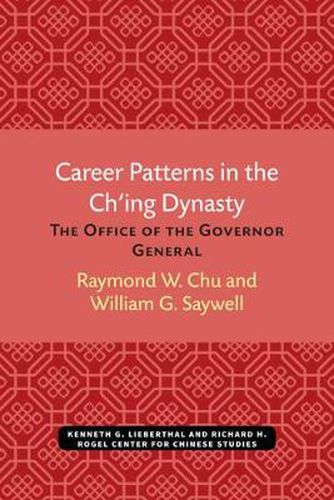Readings Newsletter
Become a Readings Member to make your shopping experience even easier.
Sign in or sign up for free!
You’re not far away from qualifying for FREE standard shipping within Australia
You’ve qualified for FREE standard shipping within Australia
The cart is loading…






The office of governor general (tsung-tu) was the highest provincial post throughout the Ch'ing dynasty. As such, it was a vital link in the control of a vast empire by a very small and alien ruling elite. This is primarily a biographical and statistical analysis of the incumbents of that office. By analyzing the biographical data of those who held the position of governor-general, much may be learned about the nature of the office itself. However, the main objective of the study is to provide information on career patterns, that is, the variety of different posts held from the first official appointment to that of governor-general, of an important cross section of successful Ch'ing bureaucrats. By plotting and analyzing the different patterns their official careers took, we should be able to determine what kind of men reached the top of China’s provincial and national administration during the final centuries of China’s imperial history; the qualifications that were required; the factors which prompted rapid promotion or sudden disgrace. We should also be able to determine the extent to which these and other factors varied markedly among Manchu, Mongol, Chinese Bannerman, and Han incumbents and whether changes throughout the dynasty can be detected in policies concerning the office or in the career patterns of its personnel. If such detection is possible, this study may lend support to the view that late imperial China was not static, but a society undergoing significant changes. [xi]
$9.00 standard shipping within Australia
FREE standard shipping within Australia for orders over $100.00
Express & International shipping calculated at checkout
The office of governor general (tsung-tu) was the highest provincial post throughout the Ch'ing dynasty. As such, it was a vital link in the control of a vast empire by a very small and alien ruling elite. This is primarily a biographical and statistical analysis of the incumbents of that office. By analyzing the biographical data of those who held the position of governor-general, much may be learned about the nature of the office itself. However, the main objective of the study is to provide information on career patterns, that is, the variety of different posts held from the first official appointment to that of governor-general, of an important cross section of successful Ch'ing bureaucrats. By plotting and analyzing the different patterns their official careers took, we should be able to determine what kind of men reached the top of China’s provincial and national administration during the final centuries of China’s imperial history; the qualifications that were required; the factors which prompted rapid promotion or sudden disgrace. We should also be able to determine the extent to which these and other factors varied markedly among Manchu, Mongol, Chinese Bannerman, and Han incumbents and whether changes throughout the dynasty can be detected in policies concerning the office or in the career patterns of its personnel. If such detection is possible, this study may lend support to the view that late imperial China was not static, but a society undergoing significant changes. [xi]